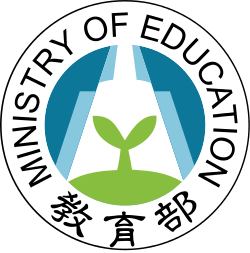National Languages Committee
|
國語推行委員會 Guóyǔ Tuīxíng Wěiyuánhuì | |
 Emblem of the Ministry of Education, Republic of China (Taiwan) | |
| Agency overview | |
|---|---|
| Formed | April 21, 1919 |
| Dissolved | January 1, 2013 |
| Superseding agency |
|
| Jurisdiction | Government of the Republic of China |
| Agency executive |
|
| Parent agency | Ministry of Education |
| Website |
www |
| National Languages Committee | |||||||||
| Traditional Chinese | 國語推行委員會 | ||||||||
|---|---|---|---|---|---|---|---|---|---|
| Simplified Chinese | 国语推行委员会 | ||||||||
| Literal meaning | National Language(s) Promotion Committee | ||||||||
| |||||||||
| Name at creation | |||||||||
| Traditional Chinese | 國語統一籌備會 | ||||||||
| Simplified Chinese | 国语统一筹备会 | ||||||||
| Literal meaning | Preparatory Commission for the Unification of the National Language | ||||||||
| |||||||||
| Second name | |||||||||
| Traditional Chinese | 國語統一籌備委員會 | ||||||||
| Simplified Chinese | 国语统一筹备委员会 | ||||||||
| Literal meaning | Preparatory Committee for the Unification of the National Language | ||||||||
| |||||||||
The National Languages Committee was established in 1928 by the Ministry of Education of the Republic of China with the purpose of standardizing and popularizing the usage of Standard Chinese (also called Mandarin) in the Republic of China. The Committee was known in English as the Mandarin Promotion Council or the National Languages Promotion Committee until 2003, but the Chinese name has not changed. The phrase Guoyu (國語 "National language") typically refers to Standard Chinese, but could also be interpreted as referring to "national languages".[1] The phrase Due to the reorganization of the Executive Yuan, the duties of the National Languages Committee were transferred to the Department of Lifelong Education's fourth sector (Reading and Language Education), starting from 2013.[2]
It was created as the Preparatory Commission for the Unification of the National Language by the Republic (then still based in Nanjing) on April 21, 1919. On December 12, 1928, the Commission was renamed to the Preparatory Committee for the Unification of the National Language, headed by Woo Tsin-hang and had 31 members. The Committee was revived in 1983 as the Mandarin Promotion Council based on Taiwan.
The decisions reached by the Council include:
- Changing the first- and second-grade textbook titles from Guowen (國文 "National Script") to Guoyu (國語 "National language"), on January 24, 1920
- Publishing the Guoyin Zidian (國音字典 "National Pronunciation Dictionary") edited by Woo Tsin-hang, on December 24, 1920. The Guoyin Zidian later became the Mandarin Chinese Dictionary (國語辭典; Guóyǔ Cídiǎn), a comprehensive online[3] and CD-ROM Traditional Chinese Mandarin dictionary.
The Committee for National Language Romanization (羅馬字母拼音研究委員會) under the Council selects and modifies Romanization Systems. The official Mandarin romanization systems in the Republic of China have been:
- Gwoyeu Romatzyh (1928–1984)
- Mandarin Phonetic Symbols II (1984–2002)
- Tongyong Pinyin (2002–2008)
- Hanyu Pinyin (starting on January 1, 2009)
Since the Taiwanization movement took hold in government, the Committee also handles:
- Researching mainland China Mandarin
- Researching the Formosan languages
- Researching other varieties of Chinese or languages like Hakka and Taiwanese Hokkien
See also
- List of language regulators
- Speak Mandarin Campaign (Singapore)
References
- ↑ Tsao, Feng-fu (2008). "Chapter 6: The Language Planning Situation in Taiwan: An Update". In Kaplan, Robert B.; Baldauf, Richard B. Language Planning and Policy in Asia: Japan, Nepal, Taiwan and Chinese Characters. 1. Bristol, UK: Multilingual Matters. p. 286. ISBN 9781847690951. OCLC 214322775.
- ↑ 李婉慈 (26 February 2013). "國語推行委員會承辦的本國語文業務,改由業務換由「終身教育司」的「第四科閱讀及語文教育科」承辦". 教育部國民小學師資培用聯盟學習領域平台 (in Chinese). National Taichung University of Education. Retrieved 28 November 2014.
- ↑ "教育部重編國語辭典修訂本". 中華民國教育部. 1994. Retrieved 2010-05-16.
External links
- National Languages Committee official website
- National Languages Committee: mandate (in the English-language section of the Ministry of Education website)